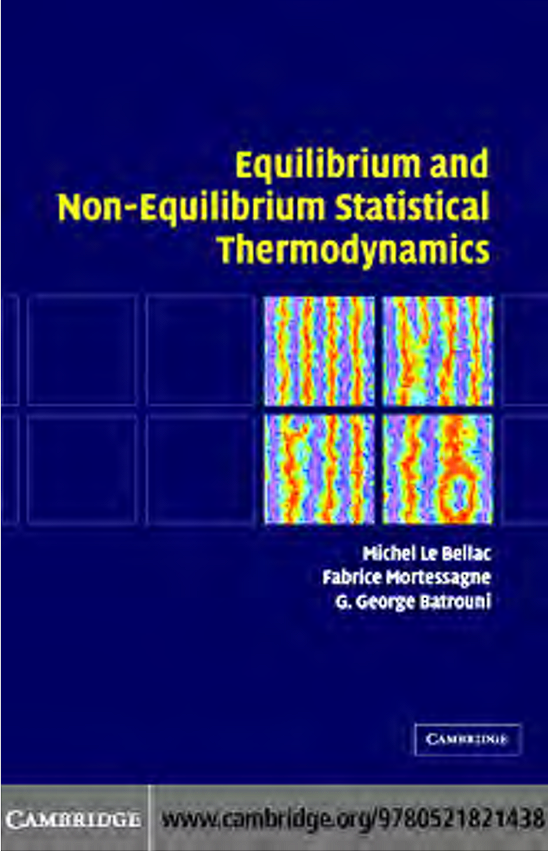
EQUILIBRIUM AND NON-EQUILIBRIUM STATISTICAL THERMODYNAMICS
Author: MICHEL LE BELLAC, FABRICE MORTESSAGNE AND G. GEORGE BATROUNI Category: Fisika Matematis, Fisika Statistik, Fisika Teoritis, Termodinamika Publisher: Cambridge University Press ISBN: 978-0-511-19444-3 This book attempts to give at a graduate level a self-contained, thorough and ped
agogic exposition of the topics that, we believe, are most fundamental in modern
statistical thermodynamics. It follows a balanced approach between the macro
scopic (thermodynamic) and microscopic (statistical) points of view.
Thefirst half of the bookcoversequilibrium phenomena. Westart withathermo
dynamic approach in the first chapter, in the spirit of Callen, and we introduce the
concepts of equilibrium statistical mechanics in the second chapter, deriving the
Boltzmann–Gibbs distribution in the canonical and grand canonical ensembles.
Numerous applications are given in the third chapter, in cases where the effects
of quantum statistics can be neglected: ideal and non-ideal classical gases, mag
netism, equipartition theorem, diatomic molecules and first order phase transitions.
The fourth chapter deals with continuous phase transitions. We give detailed ac
counts of symmetry breaking, discrete and continuous, of mean field theory and
of the renormalization group and we illustrate the theoretical concepts with many
concrete examples. Chapter 5 is devoted to quantum statistics and to the discus
sion of many physical examples: Fermi gas, black body radiation, phonons and
Bose–Einstein condensation including gaseous atomic condensates.
Chapter 6 offers an introduction to macroscopic non-equilibrium phenomena.
We carefully define the notion of local equilibrium and the transport coefficients
together with their symmetry properties (Onsager). Hydrodynamics of simple flu
ids is used as an illustration. Chapter 7 is an introduction to numerical methods, in
which we describe in some detail the main Monte Carlo algorithms. The student
will find interesting challenges in a large number of problems in which numeri
cal simulations are applied to important classical and quantum models such as the
Ising, XY and clock (vector Potts) models, as well as lattice models of superfluid
ity.
Kinetic theory receives a thorough treatment in Chapter 8 through the analy
sis of the Boltzmann–Lorentz model and of the Boltzmann equation. The book
ends with general non-equilibrium methods such as linear response, the projection
method, the fluctuation-dissipation theorem and the Langevin and Fokker–Planck
equations, including numerical simulations.
We believe that one of this book’s assets is its large number of exercises and
problems. Exercises pose more or less straightforward applications and are meant
to test the student’s understanding of the main text. Problems are more challenging
and some of them, especially those of Chapter 7, may be used by the instructor as
mini-research projects. Solutions of a selection of problems are available on the
web site.
Statistical mechanics is nowadays such a broad field that it is impossible to re
view in its entirety in a single volume, and we had to omit some subjects to main
tain the book within reasonable limits or because of lack of competence in spe
cialized topics. The most serious omissions are probably those of the new meth
ods using chaos in non-equilibrium phenomena and the statistical mechanics of
spin glasses and related subjects. Fortunately, we can refer the reader to excellent
books: those by Dorfman [33] and Gaspard [47] in the first case and that of Fisher
and Hertz [42] in the second.
The book grew from a translation of a French version by two of us (MLB and
FM), Thermodynamique Statistique, but it differs markedly from the original. The
text has been thoroughly revised and we have added three long chapters: 4 (Critical
phenomena), 7 (Numerical simulations) and 9 (Topics in non-equilibrium statisti
cal mechanics), as well as a section on the calculation of transport coefficients in
the Boltzmann equation
Back